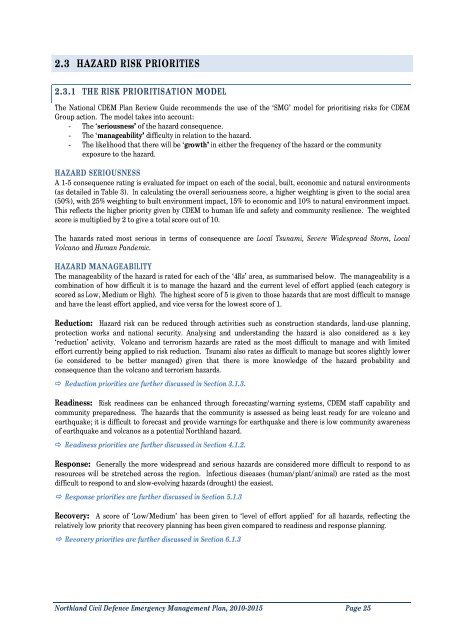Northland Civil Defence Emergency Management Plan, 2010
Northland Civil Defence Emergency Management Plan, 2010
Northland Civil Defence Emergency Management Plan, 2010
- No tags were found...
Create successful ePaper yourself
Turn your PDF publications into a flip-book with our unique Google optimized e-Paper software.
2.3 HAZARD RISK PRIORITIES2.3.1 THE RISK PRIORITISATION MODELThe National CDEM <strong>Plan</strong> Review Guide recommends the use of the ‘SMG’ model for prioritising risks for CDEMGroup action. The model takes into account:- The ‘seriousness’ of the hazard consequence.- The ‘manageability’ difficulty in relation to the hazard.- The likelihood that there will be ‘growth’ in either the frequency of the hazard or the communityexposure to the hazard.HAZARD SERIOUSNESSA 1-5 consequence rating is evaluated for impact on each of the social, built, economic and natural environments(as detailed in Table 3). In calculating the overall seriousness score, a higher weighting is given to the social area(50%), with 25% weighting to built environment impact, 15% to economic and 10% to natural environment impact.This reflects the higher priority given by CDEM to human life and safety and community resilience. The weightedscore is multiplied by 2 to give a total score out of 10.The hazards rated most serious in terms of consequence are Local Tsunami, Severe Widespread Storm, LocalVolcano and Human Pandemic.HAZARD MANAGEABILITYThe manageability of the hazard is rated for each of the ‘4Rs’ area, as summarised below. The manageability is acombination of how difficult it is to manage the hazard and the current level of effort applied (each category isscored as Low, Medium or High). The highest score of 5 is given to those hazards that are most difficult to manageand have the least effort applied, and vice versa for the lowest score of 1.Reduction: Hazard risk can be reduced through activities such as construction standards, land-use planning,protection works and national security. Analysing and understanding the hazard is also considered as a key‘reduction’ activity. Volcano and terrorism hazards are rated as the most difficult to manage and with limitedeffort currently being applied to risk reduction. Tsunami also rates as difficult to manage but scores slightly lower(ie considered to be better managed) given that there is more knowledge of the hazard probability andconsequence than the volcano and terrorism hazards. Reduction priorities are further discussed in Section 3.1.3.Readiness: Risk readiness can be enhanced through forecasting/warning systems, CDEM staff capability andcommunity preparedness. The hazards that the community is assessed as being least ready for are volcano andearthquake; it is difficult to forecast and provide warnings for earthquake and there is low community awarenessof earthquake and volcanos as a potential <strong>Northland</strong> hazard. Readiness priorities are further discussed in Section 4.1.2.Response: Generally the more widespread and serious hazards are considered more difficult to respond to asresources will be stretched across the region. Infectious diseases (human/plant/animal) are rated as the mostdifficult to respond to and slow-evolving hazards (drought) the easiest. Response priorities are further discussed in Section 5.1.3Recovery: A score of ‘Low/Medium’ has been given to ‘level of effort applied’ for all hazards, reflecting therelatively low priority that recovery planning has been given compared to readiness and response planning. Recovery priorities are further discussed in Section 6.1.3<strong>Northland</strong> <strong>Civil</strong> <strong>Defence</strong> <strong>Emergency</strong> <strong>Management</strong> <strong>Plan</strong>, <strong>2010</strong>-2015 Page 25
















